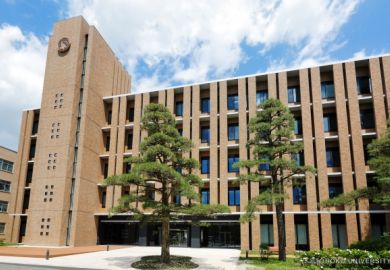View Times Higher Education's full list of the world's most prestigious universities
The term “brand” can be considered a “dirty word” among academics, says Meric Gertler, president of the University of Toronto.
“Many of them find it a distasteful concept, I think partly because it connotes ideas of superficiality and shallowness and it doesn’t really speak to the substance of what we do,” he says.
Gertler, however, looks at the word in a different way.
“Whether you like it or not, [universities] have a brand – it’s an image that people associate with us. And we want that image to be as positive as possible,” he says.
“Having said that, ultimately it does come down to substance. There has to be real substantive evidence that you have a good product to sell, that the work being done by our scholarly colleagues is of the highest rank and is well regarded around the world for its academic merit.”
Toronto certainly has all that. The institution comes 23rd in the 2016 Times Higher Education World Reputation Rankings, and is number one in Canada for the sixth year in a row.
The main reason for the university’s leading reputation is its “strengths across so many different disciplines”, from medieval studies to medicine, Gertler says. He also cites its location in a “major metropolitan city” and its pool of 540,000 alumni, who are, he says, the institution’s “greatest cheerleaders”.
“Half the people who live [in Toronto] were born outside the country; so our so-called local audience is very globalised, and they’ve got linkages to people all around the world,” he says. “That helps spread the word about us.”
Just two other Canadian universities make the top 100 of the World Reputation Rankings, but both appear in the top two-fifths of the table: the University of British Columbia is 37th and Quebec’s McGill University 39th.
But it is Canada’s North American neighbour that dominates the rankings again this year: the US claims 43 universities in the top 100 for the second year in a row. Two-thirds of these (28, up from 26 last year) make the top 50, while there are three new entries in the bottom half: Indiana University Bloomington in the 81-90 band, and Arizona State University and the University of Colorado Boulder (both in the 91-100 band). The University of Massachusetts, Mayo Medical School and Rutgers, the State University of New Jersey have all dropped out.
Indeed, stability is a striking characteristic at the top of this ranking. Despite methodological improvements this year – including weighting responses by country so as to better reflect world opinion – the same six Anglo-American “superbrands” remain at the summit for the sixth year in a row (albeit in a slightly different order): Harvard University, Massachusetts Institute of Technology, Stanford University, the University of Cambridge, the University of Oxford and the University of California, Berkeley.
Elsewhere, however, there is more volatility.
Germany again puts in the third strongest national performance, with the same six institutions representing it, but four of these have dropped down the list, and four of the Netherlands’ five representatives have also slipped this year.
How the top 30 places have changed in the World Reputation Rankings
The UK remains the second most-represented nation in the list, with 10 institutions, even though two universities – the University of Bristol and Durham University – have slipped out. Seven have lost ground.
Meanwhile, Denmark and Finland each had one institution in last year’s list, but this year both of these have been ranked outside the top 100.
However, while these European nations have lost ground, many Asian nations have improved their standing, building on their increasing presence in the flagship THE World University Rankings in recent years.
South Korea has two top 100 representatives, up from one last year. Seoul National University is in joint 45th place (up from the 51-60 band) and Korea Advanced Institute of Science and Technology (KAIST) debuts in the 81-90 band.
Hong Kong has also gained one representative to take its total to three: the University of Hong Kong is in joint 45th place (up from 51-60) and the Chinese University of Hong Kong has joined the Hong Kong University of Science and Technology in the 71-80 band.
But setting the pace in Asia are China and Japan, with five universities each, up from two each last year. China’s Tsinghua University makes the top 20 for the first time in 18th place, while Peking University climbs 11 places to 21st. The top Asian institution is Japan’s University of Tokyo, which remains in 12th place.
Tokyo’s president, Makoto Gonokami, says that until recently, the institution targeted domestic students, but it has widened its horizons and its increasingly international outlook is helping it to sustain its global reputation.
“An increasing number of international students and researchers, particularly at the graduate level, are spreading our reputation to the world and internationalising the campus at the same time,” he says.
“Further, our achievements are both created in partnership with and transmitted to the international higher education community through our researchers’ deep involvement in major international research projects, student and researcher exchanges through our strategic partnerships, and memberships of university alliances such as the International Alliance of Research Universities.”
Paying attention to the international environment and establishing a global brand is, of course, important, but Lara McKay, executive director of marketing and communications at the University of Melbourne – which leads Australia’s three representatives for the sixth year in a row in joint 49th place – says that institutions should not neglect or underestimate their local audience.
Last year, Melbourne launched an A$4 million (£2.14 million) campaign to tell the stories of collaboration at the university that have led to significant research achievements. The central aim was to show the value of “collision”, telling stories such as how a botanist working with an accountant enabled the university to develop a new method for carbon accounting. These tales are told in a video in which staff and students slam together dramatically to form shapes and figures that illustrate the narrative – in this case their bodies joined to represent a tree.
Claim a free copy of the full World Reputation Rankings 2016 digital supplement
McKay says that the marketing budget for the project, which included a television advert, was too small for a global campaign, so it was important to devise something completely different that would “get shared across borders” as well as convey how the research at the university benefits the lives of the local community.
“Just on YouTube and Facebook alone, our video has had 1.5 million views. That’s pretty crazy for a university video. And that’s been viewed all over the world,” she says.
McKay adds that the campaign has changed how those in the local community perceive the university, with members of the public reporting that they “feel more positive” about the institution and saying that it “brings more to society than they ever realised”.
The idea that adjusting institutional communications strategy can be a powerful way for universities to accelerate their reputational prowess is echoed by Charles Lewington, managing director of the consulting firm Hanover, which specialises in advising global brands and businesses on reputation.
One way in which institutions can do this is by selecting a “shortlist of their best communicators by department and ensuring that they’re well media-trained”, he suggests. “Then ask other departments at the university to work with broadcasters and other media outlets to promote the brains.”
Publicist Mark Borkowski, who has advised large corporate operations including Vodafone, Selfridges and Mercedes-Benz and managed crisis communication at the National Theatre and at Universal Music Group, adds that institutions should “do a huge audit” of their resources and then focus on promoting strengths in research and teaching and organising events that “reach the outside world”.
However, he advises universities to eschew “gimmicky” PR, something that he describes as “the equivalent in the classical music world of putting violin trios in short skirts and trying to get them launched on Britain’s Got Talent”.
“Sometimes the best advice is the obvious, which is stick to your knitting,” he says.
Toronto’s Gertler adds that it is important for universities to shape their own narrative “rather than leaving it to chance”.
He says that the institution recently overhauled its communications department, bringing several vice-presidential positions under one vice-president of communications to create a more coordinated strategy. It now targets media stories in locations where there are lots of alumni, such as New York, San Francisco, Los Angeles and Washington DC.
Toronto has also fundamentally altered its attitude towards communications, he says, shifting from a “defensive” outlook aimed at preventing information “from leaking out” to one that is “much more transparent and open, where we lead with our story” – an approach that he says is particularly effective when dealing with negative publicity.
“We’re much more open in sharing this information,” he says, “but in doing so we really tell our own story about what we think has happened and why and what we’re going to do about it, rather than waiting for someone else to tell our story for us.”
POSTSCRIPT:
Print headline: Success stories
Register to continue
Why register?
- Registration is free and only takes a moment
- Once registered, you can read 3 articles a month
- Sign up for our newsletter
Subscribe
Or subscribe for unlimited access to:
- Unlimited access to news, views, insights & reviews
- Digital editions
- Digital access to THE’s university and college rankings analysis
Already registered or a current subscriber?











